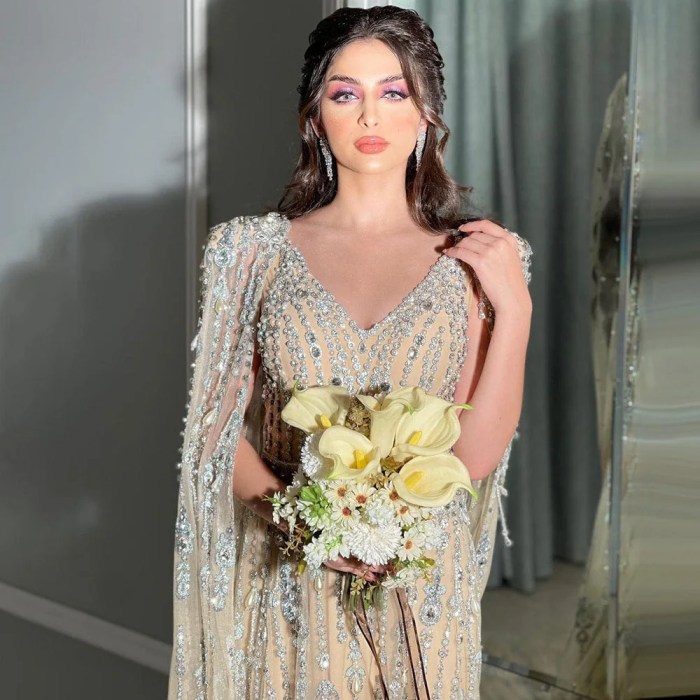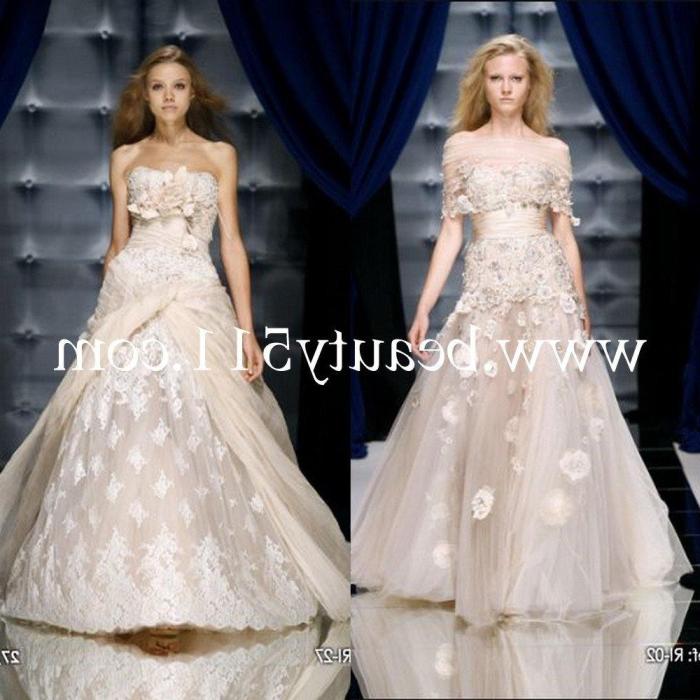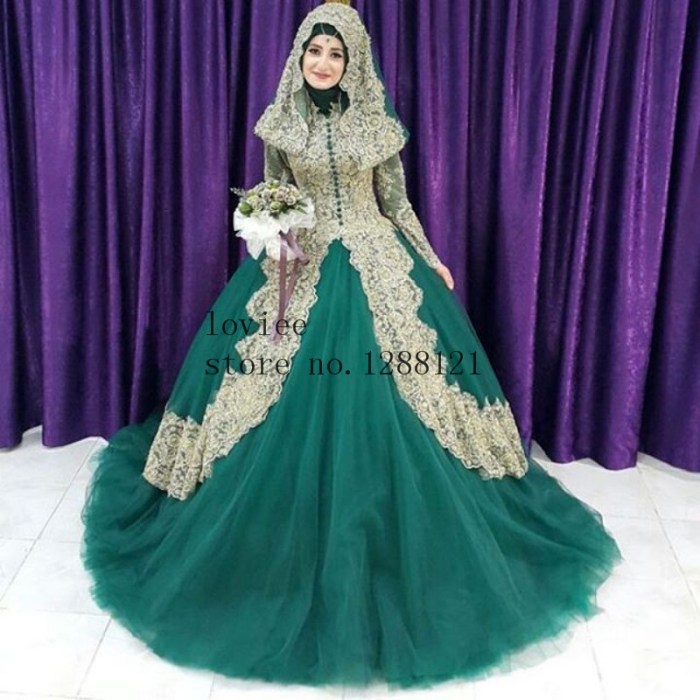Arabic Style Wedding Dresses: A Celebration of Tradition and Modernity
Arabic style wedding dresses – Arabic wedding dresses are renowned for their opulent beauty, reflecting a rich tapestry of cultural heritage and artistic expression. This exploration delves into the defining characteristics of these stunning garments, examining their evolution, regional variations, and the modern interpretations that continue to captivate.
Defining “Arabic Style” in Wedding Dresses
Arabic wedding dress styles exhibit significant diversity across different regions, yet share common threads. Key characteristics include luxurious fabrics, intricate embellishments, and silhouettes that flatter the figure. While traditional attire varies considerably from region to region, a common theme is the emphasis on opulence and elegance, reflecting the significance of the wedding ceremony within the culture.
Traditional attire in the Levant, for instance, often features heavier embroidery and more structured silhouettes compared to the flowing, lighter styles prevalent in the Gulf region. North African styles, influenced by Berber and other cultural traditions, often incorporate unique patterns and color palettes. This evolution reflects both the passage of time and the diverse cultural influences within the Arab world.
Over time, Arabic wedding dresses have adapted to incorporate both global fashion trends and the enduring influence of local traditions. Early styles often favored simpler designs and locally sourced fabrics, while modern interpretations blend traditional elements with contemporary aesthetics.
| Region | Typical Fabrics | Embellishments | Silhouettes |
|---|---|---|---|
| Levant (e.g., Lebanon, Syria) | Heavy silk brocade, embellished velvet | Intricate embroidery, heavy beading, sequins | A-line, empire waist, fitted bodice |
| Gulf Region (e.g., UAE, Saudi Arabia) | Lightweight silk, organza, chiffon | Delicate embroidery, pearls, Swarovski crystals | A-line, flowing ballgown, mermaid |
| North Africa (e.g., Morocco, Algeria) | Silk, satin, heavy brocade, often incorporating traditional weaving techniques | Metallic threads, intricate embroidery, beading, kaftans | A-line, kaftan-style, flowing maxi dresses |
Fabrics and Embellishments, Arabic style wedding dresses

Source: etsystatic.com
The fabrics and embellishments used in Arabic wedding dresses are integral to their beauty and cultural significance. Luxurious materials like silk, lace, organza, and velvet are commonly employed, each offering unique textural and visual qualities.
Traditional embellishments often include intricate embroidery, beading, sequins, and precious stones, reflecting the artistry and craftsmanship of the region. The cultural significance of specific fabrics and embellishments varies depending on the region and family traditions; for example, certain embroidery patterns might represent good luck or family heritage.
- Heavy Embroidery: Creates a richly textured and visually stunning effect, often depicting floral motifs or geometric patterns.
- Beading: Adds a touch of sparkle and glamour, ranging from delicate seed beads to larger, more dramatic embellishments.
- Sequins: Offer a shimmering effect, particularly popular in modern designs.
- Crystal embellishments: Adds a luxurious touch, often using Swarovski crystals or other high-quality stones.
- Metallic threads: Incorporate gold or silver threads into the embroidery, enhancing the richness and opulence of the design.
Silhouettes and Styles

Source: googleusercontent.com
Arabic style wedding dresses often feature intricate embroidery and luxurious fabrics. The exquisite detail can be enhanced by incorporating modern techniques, such as the stunning three-dimensional effects achieved with a 3d applique wedding dress , adding a contemporary twist to traditional designs. This results in a truly unique and memorable bridal look, perfectly blending classic Arabic elegance with innovative design elements.
Arabic wedding dress silhouettes are as diverse as the regions they represent. Popular choices include A-line, mermaid, and ballgown styles, each offering a unique aesthetic and flattering different body types. The choice of silhouette is often influenced by cultural traditions, personal preferences, and the overall aesthetic of the wedding.
Modern interpretations of traditional silhouettes often incorporate contemporary design elements while retaining the essence of traditional styles. For example, a modern take on a traditional A-line gown might feature a more fitted bodice and a flowing skirt, incorporating contemporary fabrics and embellishments.
A-line silhouettes are generally flattering on most body types. Mermaid styles accentuate the curves, while ballgowns create a dramatic and regal look.
Color Palettes and Trends
Traditional color palettes for Arabic wedding dresses often feature rich jewel tones such as emerald green, ruby red, sapphire blue, and gold. These colors are often associated with prosperity, royalty, and good fortune. Modern trends show a wider range of colors, including pastels and more muted tones, while still incorporating traditional elements.
Regional variations also influence color preferences. For example, ivory and off-white are more commonly seen in some regions, while bolder colors are favored in others.
- Classic Ivory (#FFFFF0): Timeless and elegant.
- Royal Blue (#4169E1): Rich and regal.
- Emerald Green (#50C878): Luxurious and vibrant.
- Rose Gold (#B76E79): Romantic and modern.
- Champagne (#F7E7CE): Soft and sophisticated.
Accessories and Headwear
Accessories play a crucial role in completing the look of an Arabic wedding dress. Jewelry, veils, and belts are commonly used to add sparkle, elegance, and cultural significance. Headwear, in particular, holds immense cultural importance, varying widely across different regions.
Traditional headwear styles range from elaborate jeweled tiaras to simple veils, often reflecting family traditions and regional customs. Modern interpretations incorporate contemporary designs while still paying homage to traditional styles.
- Tarha (Headband): Often adorned with jewels and pearls, common in the Levant.
- Veil: Can range from simple to elaborate, often symbolizing modesty and purity.
- Crown: A more modern interpretation, adding a regal touch.
- Flower Crowns: A more contemporary and bohemian choice.
- Elaborate Headpieces: Incorporating feathers, crystals, and other embellishments.
Modern Interpretations of Traditional Designs

Source: emasscraft.org
Modern designers are reinterpreting traditional Arabic wedding dress elements by incorporating contemporary fabrics, silhouettes, and embellishments while maintaining the cultural essence of the designs. This blend of tradition and modernity creates unique and breathtaking gowns.
Sustainable and ethical practices are increasingly being integrated into the creation of modern Arabic wedding dresses. This includes using eco-friendly fabrics, supporting local artisans, and minimizing waste.
Illustrative Examples
Imagine a breathtaking A-line gown in ivory silk, heavily embroidered with intricate floral patterns in silver thread, complemented by a delicate veil and a jeweled tiara. The gown’s flowing silhouette creates a sense of effortless elegance.
Another example might be a mermaid gown in deep emerald green velvet, adorned with beading and sequins, paired with a matching headpiece and statement earrings. The rich color and luxurious fabric create a dramatic and sophisticated look.
Finally, consider a flowing kaftan-style gown in blush pink organza, delicately embroidered with floral motifs. The gown’s relaxed silhouette and soft color palette offer a romantic and ethereal feel. This could be paired with a simple flower crown and delicate gold jewelry for a bohemian-chic aesthetic.
A complete bridal look might include a champagne-colored A-line gown with delicate lace detailing, a flowing veil, a delicate gold necklace, subtle makeup emphasizing the eyes, and a loose, romantic updo. The overall effect is one of understated elegance and timeless beauty.
FAQ Resource
What is the average price range for an Arabic style wedding dress?
The price varies greatly depending on the designer, fabrics, embellishments, and level of customization. Expect a wide range, from several thousand dollars to tens of thousands.
Where can I find Arabic style wedding dresses?
Many designers specialize in Arabic bridal wear. You can find them through online boutiques, bridal shops specializing in cultural attire, and at designer showrooms.
How long does it typically take to have a custom Arabic wedding dress made?
Custom designs usually require several months, sometimes longer, depending on the designer’s workload and the complexity of the dress.
Can I alter a non-Arabic style wedding dress to incorporate Arabic elements?
Yes, many alterations can be made to add elements like embellishments, sleeves, or headwear to achieve a more Arabic aesthetic.